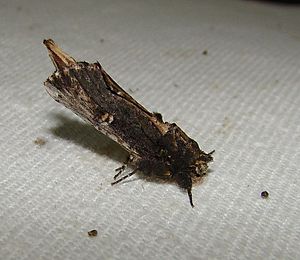Morning-glory prominent moth facts for kids
Quick facts for kids Morning-glory prominent moth |
|
|---|---|
 |
|
| Scientific classification | |
| Kingdom: | |
| Phylum: | |
| Class: | |
| Order: | |
| Family: |
Notodontidae
|
| Genus: |
Schizura
|
| Species: |
S. ipomoeae
|
| Binomial name | |
| Schizura ipomoeae Doubleday, 1841
|
|
| Synonyms | |
|
|
The morning-glory prominent moth (scientific name: Schizura ipomoeae) is a fascinating insect. It's also known as the false unicorn caterpillar. This moth belongs to a group called Notodontidae. Edward Doubleday first described it in 1841. You can find this moth in the United States and southern Canada.
Contents
About the Morning-Glory Prominent Moth
What Does It Look Like?
This moth has a wingspan of about 36 to 47 millimeters. That's roughly the length of a small paperclip! Its front wings are usually brownish-grey. They often have cool patterns of black lines and spots. The back wings are different for males and females. Males have whitish back wings, while females have darker grey ones.
When Can You See Them?
Adult moths fly at different times depending on where they live. In the southern parts of their home, you might see them from April to September. In the north, they fly from June to August. In the northern areas, there is usually only one group of moths born each year.
Life Cycle and What They Eat
The young moths, called larvae or caterpillars, eat the leaves of many different woody plants. They enjoy leaves from trees like beech, birch, elm, and maple. They also like oak and rose plants. You can find these caterpillars munching on leaves from May to October.
When winter comes, the moth is in its pupal stage. This is like a resting stage where it changes from a caterpillar into an adult moth. It stays in this stage until the weather gets warmer.
Gallery




